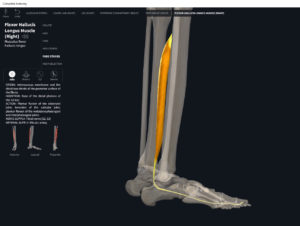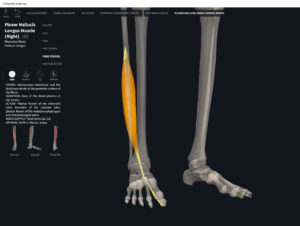Anatomy & Physiology: Muscles—Flexor Hallucis Longus.
Structure.
- Origin: inferior 2/3 of fibula.
- Insertion: distal phalanges of great toe.
Function.
- Concentric action: ankle plantar flexion, flexion of distal and middle phalanges of toes at interphalangeal joints and proximal phalanx of each toe at metatarsophalangeal joint.
- Reverse mover action: plantarflexion; inversion/supination; flex metatarsal at MTP joint and proximal phalanx at IP.
- Eccentric action: controls/restrains/decelerates big toe atMTP and IP, and metatarsal at MTP; dorsiflexion of ankle; eversion at subtalar joint.
- Isometric action: stabilize ankle, subtalar, and MTP and IP joints.
- Innervation: tibial nerve.
- Arterial supply: posterior tibial artery.
Clinical Significance.
More.
References
Biel, A. (2015). Trail guide to the body: A hands-on guide to locating muscles, bones and more.
Clark, M., Lucett, S., Sutton, B. G., & National Academy of Sports Medicine. (2014). NASM essentials of corrective exercise training. Burlington, MA: Jones & Bartlett Learning.
Jenkins, G., & Tortora, G. J. (2012). Anatomy and Physiology: From Science to Life, 3rd Edition International Stu. John Wiley & Sons.
Muscolino, J. E. (2017). The muscular system manual: The skeletal muscles of the human body.



